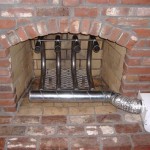Can You Use Fireplace Ashes In Your Garden?
Fireplace ashes, a byproduct of burning wood in a fireplace or wood stove, have long been considered a potential soil amendment. However, the suitability of using these ashes in a garden depends on several factors, primarily the type of wood burned, the composition of the soil, and the specific needs of the plants being cultivated. Understanding the properties of wood ash and its potential impact on soil chemistry is crucial before incorporating it into a garden setting.
Wood ash is primarily composed of calcium carbonate, potassium, phosphorus, and various trace minerals. These elements are derived from the wood itself and concentrated during the burning process. The exact composition can vary depending on the species of tree burned and the completeness of the combustion. Hardwoods, such as oak and maple, generally produce ash with a higher nutrient content compared to softwoods like pine.
The beneficial properties of wood ash are primarily attributed to its liming effect and its contribution of essential nutrients. As a liming agent, wood ash can raise the pH of acidic soils, making nutrients more available to plants. The potassium and phosphorus content can also contribute to plant growth, particularly in soils deficient in these elements. The trace minerals present in wood ash can further enhance plant health by providing micronutrients often lacking in heavily cultivated soils.
Understanding the Risks: Alkaline Soil and Heavy Metals
Despite its potential benefits, the use of fireplace ashes in gardens carries certain risks. The most significant concern is the alkaline nature of wood ash. Applying excessive amounts of ash can raise the soil pH to levels that are detrimental to plants that prefer acidic conditions, such as blueberries, azaleas, and rhododendrons. The high pH can also reduce the availability of certain micronutrients, like iron and manganese, leading to nutrient deficiencies in susceptible plants.
Another potential hazard is the presence of heavy metals in wood ash. Wood can absorb heavy metals from the soil it grows in, and these metals can become concentrated in the ash during burning. While the levels are generally low, repeated applications of wood ash over time can lead to a buildup of heavy metals in the soil, potentially contaminating edible plants. It is crucial to avoid using ash from treated wood, such as painted, stained, or pressure-treated wood, as these often contain high concentrations of toxic chemicals.
The source of the wood is paramount. Only ash from untreated, natural wood should be considered for garden use. Burning trash, cardboard, or other materials in a fireplace can contaminate the ash with harmful substances that should not be introduced into the soil.
Proper Application Techniques and Considerations
To mitigate the risks associated with using fireplace ashes in the garden, it is essential to follow proper application techniques. The first step is to test the soil pH. This can be done using a commercially available soil testing kit or by sending a soil sample to a local extension office for analysis. If the soil is already alkaline, adding wood ash is not recommended. If the soil is acidic, wood ash can be applied carefully to raise the pH.
The recommended application rate for wood ash is generally around 10-20 pounds per 100 square feet. It is best to apply the ash in the fall or winter, allowing it to weather and integrate into the soil before planting in the spring. The ash should be spread evenly and incorporated into the top few inches of soil using a rake or tiller. Avoid applying wood ash directly to plant foliage, as it can cause burns due to its alkalinity.
It is usually a good idea to mix ashes into compost before applying to the garden. This can help to neutralize the pH and distribute the nutrients more evenly. Also, composting the ash first can help to minimize the dust and fly-away particles.
Suitable Plants and Soil Types for Wood Ash Application
Wood ash is most beneficial for plants that prefer slightly alkaline soil conditions. These include vegetables like tomatoes, peppers, and beans, as well as many flowering plants such as clematis, lavender, and peonies. These plants can benefit from the increased availability of calcium and potassium provided by the ash.
Wood ash is particularly well-suited for clay soils, which tend to be acidic and often deficient in calcium. The liming effect of the ash can help to improve soil structure by breaking up clay particles and increasing drainage. The addition of potassium and other nutrients can also improve the fertility of clay soils.
Sandy soils, on the other hand, generally benefit less from wood ash application. Sandy soils tend to be well-drained and less prone to acidification. The addition of wood ash to sandy soils can also exacerbate nutrient deficiencies, as the high pH can reduce the availability of micronutrients. Additionally, sandy soils are often already alkaline, requiring no further pH adjustment.
In summary, the appropriate use of fireplace ashes in the garden involves careful consideration of the wood source, soil pH, plant preferences, and application techniques. When used judiciously, wood ash can be a valuable soil amendment, providing essential nutrients and improving soil structure. However, excessive or improper application can lead to soil imbalances and plant damage. Regular soil testing and careful monitoring of plant health are crucial to ensure the safe and effective use of wood ash in any garden setting.

Are Fireplace Ashes Good For The Garden Vertical Chimney Care

Fireplace Ash Can Be A Boost For Garden Soil But Cautious The Seattle Times

10 Fantastic Uses For Fireplace Ash Full Service Chimney

How To Dispose Of Fireplace Ash And Reuse It White Glove Chimney

How To Use Wood Ash In The Garden Stuff

Are Fireplace Ashes Safe For My Garden

20 Brilliant Ways To Use Wood Ash In The Garden Gardening

Yearly Additions Of Fireplace Ash To Garden Can Cause More Harm Than Good Triblive Com

Is Firepit Ash Good For Grass

How To Compost Wood Ashes Gardener S Path
Related Posts








